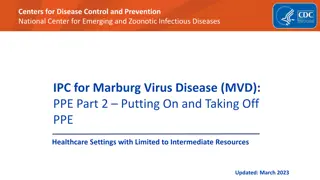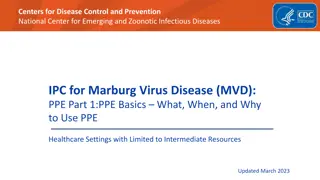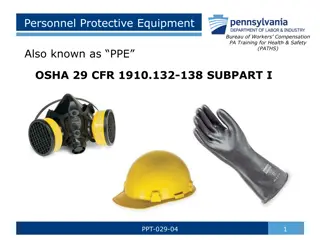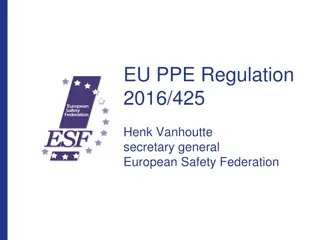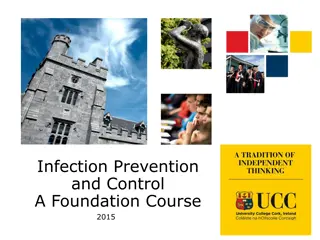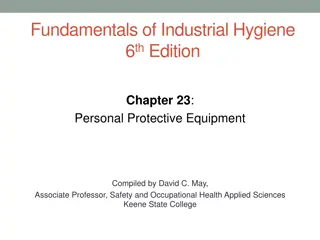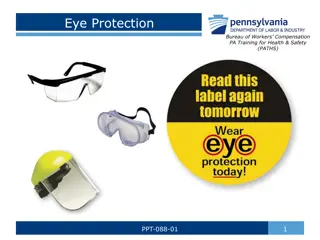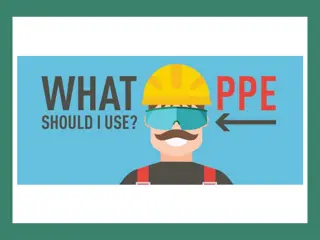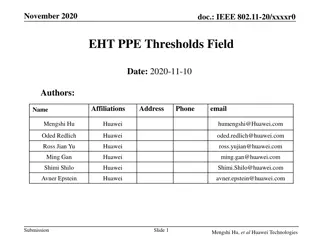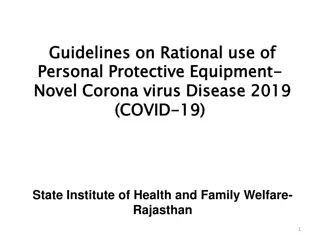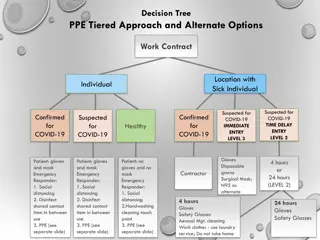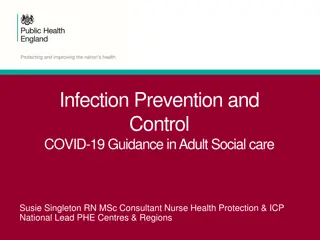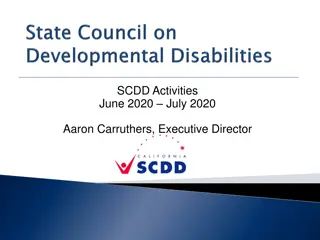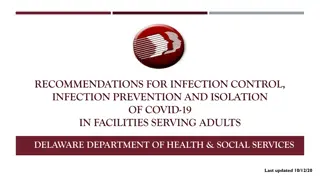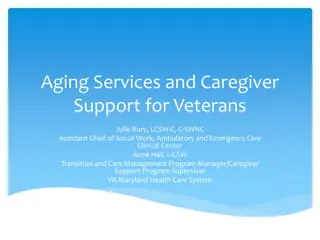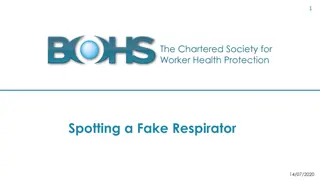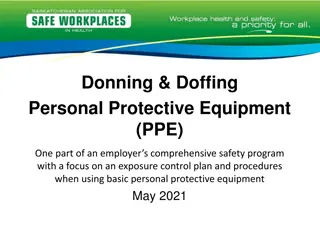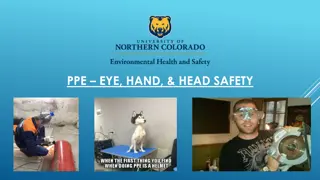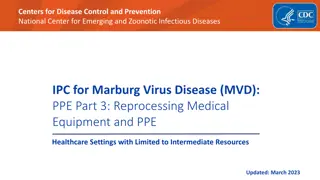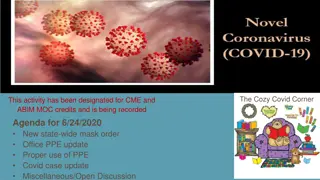Community-based Home Care: PPE Introduction & Support Strategies
Explore the essentials of community-based home care including PPE usage, infection prevention measures, and the roles of caregivers and volunteers. Learn about the importance of minimizing the spread of COVID-19 within families and communities, while ensuring proper protection for all individuals involved.
Download Presentation

Please find below an Image/Link to download the presentation.
The content on the website is provided AS IS for your information and personal use only. It may not be sold, licensed, or shared on other websites without obtaining consent from the author. Download presentation by click this link. If you encounter any issues during the download, it is possible that the publisher has removed the file from their server.
E N D
Presentation Transcript
Community based home care, PPE, introduction to contact tracing and community based surveillance Revised 14 April 2020 Presentation number 3
Learning objectives By the end of this session, participants will understand: How to support the community in safe home based care messages Minimise the spread to other family and community members through key messages Protect yourself Protect your family Protect your community
.lets start with a question. What do you think are important considerations if someone wants to be at home with the Corona virus instead of being in hospital?
Home based care why? Health facility care not available Too far away Overwhelmed with cases Limited resources available Refusal by the sick person to go to a health facility for care Mild symptoms only
Home based care messaging - infection prevention The sick person must be isolated from rest of family in different room and should wear a mask when their carer comes into room The room should have good ventilation (air flow) One person in the family should be the care giver (someone who is in good health) The carer should observe social distancing when not providing immediate care The carer should practice good hand hygiene frequently before and after caring for the sick person
Home based care messaging - infection prevention continued No other visitors! The carer should be supplied with personal protection equipment (masks and gloves) The room should be cleaned each day (wash bedlinen, clothes and wipe down surfaces with HH bleach or disinfectant)
RCRC volunteer role What do you think the RCRC volunteer can do to help with someone who is receiving home based care?
RCRC role Deliver key messages in the community and ensure family members of anyone who is sick is aware Social distancing (advise family about carers role and no other visitors) Volunteer may have to assist with referral to clinic Notify branch supervisor who can notify MoH health personnel Notify supervisor if a lot of vulnerable people in the community
Case management and referral Encourage the sick person to have plenty of rest Encourage them to drink plenty of fluids Assist in getting help if the person is having trouble breathing or unconscious (can t wake them up) Managing fever and dehydration (ECV tools for managing a fever and preparation of ORS)
Group scenario for volunteers The following scenario can be completed as a group or individually, ask yourself what you would do
Scenario You are visiting the community to deliver key messages when the community leader asks you to come to his house to see his mother. He asks you to come inside to check her as she has been very unwell with a fever and cough for the last 2 days. He thinks she may have the virus.
Group work In your group discuss the following: 1. Do you enter the house? Is it safe? 2. What infection prevention control measures should you use? 3. What support could you give? To the person who is sick To the family To the carer
Scenario - Entering the house If unsure contact your branch supervisor first: Avoid close contact (social distancing) by staying at least 1 metre away Wash you hands with soap and water for at least 20 seconds Take a mask in with you and ask the woman to put it on while you are there Do not touch the person Advise the person that they should go to the clinic to be checked (especially if elderly or has other diseases such as asthma, heart disease, diabetes ) Offer to ring the closest clinic to advise them a sick person is in the community and is coming to be checked
Scenario advice for home care Social distancing by the rest of the family (only one carer should provide any direct care) Sick person must stay in a separate room Ensure that if the same bathroom is used by the whole family that surfaces are cleaned with an alcohol based cleaner or household bleach every day Ensure that separate kitchen utensils are used and washed properly in boiling water and kept aside for the sick person only Make sure a rubbish bin with a lid is in the room with the sick person so she can dispose of dirty tissues or any other rubbish separately.
Scenario discussion with son/family Make sure only one carer provides care for his mother (the carer should be healthy, understand the infection prevention measures necessary to decrease the risk of the virus spreading to other family members or people in the community and the need to only make contact if absolutely necessary otherwise keep at least one metre distance) The carer should have access to PPE, (masks and gloves) for when he/she has to deliver direct care that involves contact i.e changing the linen, assisting with personal care, removing rubbish) Family should purchase soap and household bleach or disinfectant for cleaning
Scenario for Branch Health Coordinators and Supervisors The following scenario can be completed as a group or individually, ask yourself what you would do
Scenario Your volunteers are visiting a community to deliver key messages when the community leader asks one of them to go to his house to see his mother. He asks him to go inside to check her as she has been very unwell with a fever and cough for the last 2 days. He thinks she may have the virus. The volunteer calls you to see what he should do, he admits to feeling frightened.
Group work or can be done individually What will you advise your volunteer?
Advice to the volunteer If worried it s ok to stay outside but advise the son to take her to the clinic to be assessed and ask him to notify the clinic first According to the risk it is ok to go into the house however : Wash hands with soap and water before entering the house and immediately upon leaving (minimum 20 seconds) Avoid close contact and ensure at least 1 metre distance is between you and the sick person If you have a mask you can give it to the sick person and ask her to put it on while you are talking to her. If you have a second mask it is ok to put it on whilst in close contact If she hasn t been to the clinic advise that she should go and be assessed Advise the son that he should call the clinic first to notify them he is bringing his mother who may have the virus
Contacts After returning outside and after washing hands thoroughly with soap and water it is useful if the volunteer can get a list of names of all people inside the house who has been in contact with the sick person. This information can be given to the clinic as a list of contacts. All contacts should be advised to stay at home until further information becomes available regarding the sick family member ( it is likely someone from the MoH will follow up all contacts and provide instructions about the next steps)
Offer debrief to volunteer Ask the volunteer team to come back to the office after their activities Provide an opportunity for them to share how they are feeling Take the opportunity to discuss their concerns
Wearing a mask Now you know that the corona virus can spread from person to person via air-droplets when someone who is infected coughs and sneezes and the key messages when do you think it is important to wear a mask? Should everyone in the family wear a mask? When you are in the community as a volunteer delivering messages should you wear a mask ? If so when?
Wearing a mask Anyone who is sick with the virus and coughing and sneezing should wear a mask when a carer enters the room or if they move outside of the room Anyone caring for a sick person suspected of having the virus should wear a mask when in the same room Anyone who wears a mask should know how to: Put it on properly Fit it firmly over the nose and face for protection Not touch their own face whilst caring for the sick person Remove carefully Dispose properly Wash hands thoroughly with soap and water before and after
More information about wearing a mask We know some country authorities are mandating the wearing of masks We know that there is a risk that the supply of masks around the world may run out and not be available for healthcare workers if everyone starts wearing masks unnecessarily IFRC, WHO and other responding organisations understand that many people are frightened and want to wear a mask Currently there is no evidence that supports if you are not sick that the mask offers any protection. There is a lot of work going on to look further into the use of masks and everyone will be updated if anything changes If community members feel strongly about making their own mask from cloth there is a pattern and recommendations available - contact your branch supervisor for more information
Mask management Locate the metal strip at top of mask and place over top of nose, secure the elastic around ears or tie strings behind your head Make sure it covers nose mouth and chin While in use do not touch the front of the mask To remove the mask take the elastic form behind your ears or untie from behind your heads Do not touch the front of the mask as it may be contaminated Remove the mask and discard into a closed rubbish bin or allocated waste disposal place Wash your hands with soap and water If your mask becomes damp or humid discard and replace with a new one
Fitting and removal of a mask - Click on and watch WHO video links below demonstrating putting on and removal of a mask https://youtu.be/Ded_AxFfJoQ https://youtu.be/lrvFrH_npQI https://www.epi- win.com/sites/epiwin/files/content/attachments/2020-02-03/How- to-use-mask-v0.1-digital.png
Wearing gloves Now you know the way the corona virus spreads from person to person and the key messages, when do you think it is important: to wear gloves? Should everyone in the family wear gloves? Should you as a volunteer in the community wear gloves? If so when?
Gloves It is more important to practice regular washing hands with soap and water before and after caring for someone who is sick or handling their belongings. If gloves are available it is advisable to use gloves when handling the persons belongings (washing) cleaning dirty surfaces and removal of any waste materials (e.g used tissues or vomit) Ensure gloves are disposed of immediately into the same rubbish container as the waste and wash hands thoroughly straight away If gloves are not available follow hand hygiene practices strictly after doing any of the above or discuss another plan
Surveillance and contact tracing What does it mean to us as RCRC?
Background The introduction of community based surveillance (CBS) gives us a much better picture of what is actually happening across the country and how far it is spreading. It gives us opportunities to try and stop it when we know where it is. RCRC are often asked to be involved in gathering information (new cases, deaths and contacts) due to their existing relationships with communities.
Community based surveillance (CBS)- what does it mean? Being alert to clusters (groups) of people with the disease and reporting it to the MoH Being alert to rumours of disease in a community and reporting it to the MoH Identify cases and refer if necessary Being alert to contacts Allows us to get a better picture of the spread of the epidemic if we capture information at the community level
Contact tracing Anyone who is in close contact with a sick person is known as a contact and is at risk of developing the sickness themselves Contacts should also stay away form the rest of the community for a period of 14 days from the time that the person developed symptoms It is important to notify the MoH when a new case develops so they can provide information to the community about what quarantine means RCRC may be asked by the community to be involved in contact tracing (the volunteer should receive training on this first)
Follow up The volunteer is the face on the ground so is well placed to: Notify their supervisor about any cases of home based care (the NS will have a contact within the MoH to report this information to) Notify the supervisor of any problems, rumours or concerns in the community
Summary RCRC volunteers usually have existing relationships with communities so are often well placed to provide information and support to families during this disease outbreak People with mild symptoms may be asked to stay and home and isolate A carer should be chosen from within the family to provide basic minimal direct care when needed, no other visitors Home care requires some level of PPE to provide safety to the carer and others in the community When someone becomes sick with the virus it is important that all contacts are found and self quarantine and the MoH is notified
Resources 1.Home Care for patients with suspected Corona virus (COVID-19) https://www.epi-win.com/sites/epiwin/files/content/attachments/2020- 03-11/WHO-nCov-IPC-HomeCare-2020.2-eng.pdf 2. Considerations for quarantine of individuals in the context of Corona virus (COVID-19) https://www.epi-win.com/sites/epiwin/files/content/attachments/2020- 03-11/WHO-2019-nCov-IHR_Quarantine-2020.1-eng.pdf 3. Advice on the use of masks in the community during home care and in health settings in the context of the Corona virus (COVID-19) https://www.epi-win.com/sites/epiwin/files/content/attachments/2020- 03-11/WHO-nCov-IPC_Masks-2020.1-eng%20%281%29.pdf


